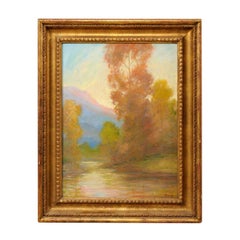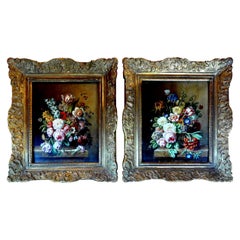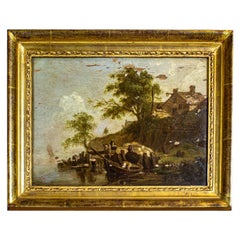David Stirling
David Stirling was born in 1887 in Corydon, Iowa, to a pioneering family, and his father was a newspaper publisher. There were 8 children in the family, of which he was the youngest, being 7 years younger than the next youngest son, and he was the first of the family to graduate from high school. Stirling went on to the Cummings Art School in Des Moines, Iowa, in 1906–07 and also attended the Academy of Fine Arts in Chicago in 1908–09. After traveling to the North West, where his older brother had a logging business in which he worked, he discovered that he wasn't too interested in that kind of work. Stirling passed through Estes Park, Colorado, on this trip in 1916. He married Kitty Wolf in Corydon, and in 1918 they moved to Estes Park for the summer months and this became a standard trek that lasted for many years. Stirling alternated his time between Corydon in the winter, where he maintained a studio over the local bank and Estes Park, where his studio was variously inside the Rocky Mountain National Park and on the main street. He painted the Rocky Mountain National Park and environs as well as other parts of the country but was most well known for his colorful aspen paintings. He worked exclusively in oils and painted on board for the most part.
In the 1920s, the Stirlings lived in Denver and Dave worked for the well known Meininger's Art Materials store there. While working there, he could afford canvas and did produce several pieces on canvas during that time. In 1919 in the Rocky Mountain National Park, they built a studio called Bugscuffle Ranch along with an adjacent home, where they lived in the summers. This structure was replaced in 1930 with the gallery and studio that remained until a few years after Stirling’s death. He became well known for his cultural lectures on art, which were given in the gallery daily, and were attended by thousands of visitors. Stirling was an author as well and wrote several books of stories, myths and lies about the mountain west. His pen name was Pye-Eyed Pete, his wife contracted cancer, and he remained her sole caregiver until her death. His daughter Hattie later also had cancer and died, and his son who was diabetic died on the dance floor of the Riverside Ballroom in Estes Park. He is survived by 4 grandchildren and 1 great-grandchild (to date). Stirling was famous as “The Youngest of the Old Masters,” a title given to him in an article, which he was quick to adopt. He painted the Rocky Mountain National Park and environs as well as other parts of the country but was most well known for his colorful aspen paintings. Stirling received many awards and citations for his artwork and community involvement. The Governor of Colorado presented him with a congratulatory sheepskin outlining his career on the occasion of his 50th anniversary as a resident artist of the Rocky Mountain National Park. Stirling died in Longmont, Colorado after a short illness in 1971 and was buried there in a family plot.
20th Century American David Stirling
Canvas, Wood
Early 20th Century French Romantic David Stirling
Wood
Late 19th Century European Antique David Stirling
Hardwood, Paint
Late 19th Century French Belle Époque Antique David Stirling
Canvas
Mid-20th Century Italian Folk Art David Stirling
Canvas, Wood
Early 20th Century French Beaux Arts David Stirling
Canvas, Wood, Paint
Mid-20th Century David Stirling
Canvas, Wood, Paint
1850s American American Empire Antique David Stirling
Canvas, Giltwood, Paint
Mid-20th Century David Stirling
Canvas, Wood, Paint
Early 20th Century French David Stirling
Wood, Paint
Late 20th Century European David Stirling
Canvas, Wood
1890s French Napoleon III Antique David Stirling
Canvas, Wood
19th Century French Empire Revival Antique David Stirling
Paint


